How to teach a child to walk?
What a joy to see the first steps of your baby! This joyful event will remain in the memory of parents for life. At someone the peanut went at 9 months (and maybe even earlier!), At someone at 1.5. What can parents do if their baby is just crawling? How to teach a child to walk?
First of all, as a rule, the baby learns to stand on its own legs, leaning and holding on to something. Most often this is a cot or ... your hands! By the way, he can even stand up to crawling, and if he got up on his own, this is simply wonderful. Hence, his musculoskeletal system is ready to withstand such a load. Do not interfere with the child. This process gives the kids a sea of emotions, opens new horizons, so they will again and again puff, but rise.
When the child is confidently standing on his legs, he begins to try to move along the support, whether it be a cot, a wall or a bedside table. This is where you can stimulate the baby to move. For example, hang a toy over the other end of the bed, if it is in the crib. If the bedside table or table, then put an attractive object for the child on the surface of the bedside table or table so that the baby does not reach out, and was forced to pass a little.
You can also do the following: stand behind the child’s back, take it by both handles (or support under the arms) and slightly pull forward. This provokes him to step. The same can be done, being, on the contrary, in front of his face. The second option is even better because the child has an additional incentive to move forward - you. Also, many babies love to walk, pushing something in front of them, such as a chair.
When the crumb begins to move more confidently, you can support it only for one hand. The main thing is to alternate them. And let him hold your finger, and not you hold his hand. So he learns movement coordination and balance.
In fact, with the support, the children quickly begin to move, but to make an independent step is more difficult. Some themselves are rapidly mastering the technique of walking on their feet. Most often this happens if you have been doing gymnastics, baby yoga, having a massage, swimming and diving training since your child’s birth. Then his musculoskeletal system matures faster for independent movement, whether it be crawling or walking. If your crumb is not in a hurry to take his first steps, be patient and help your baby than you can.
How to teach a child to walk independently
First, the baby must feel what it is like to stand without support. If he does not make independent attempts, then you give him that opportunity. Since this is a new sensation, then the child will most likely enjoy it, and he will try to repeat it himself.
Well, now you can do the first independent steps. If before the toy stood so that it could be reached along the support, then it is time to shift it a little further. For example, a child rests on a chair, and a toy is placed on another chair, positioned so that he has to take a small step.
Thus, at the initial stage of the adventures of a child, the proximity of interior objects is useful. Then he can move from one place to another, while making only 1-2 steps. Of course, it is better to cover sharp corners. Gradually, becoming more self-confident, the child will begin to take more and more steps.
Pay attention to the kid reaching. Themselves, showing how you do it, pronounce every action. Maybe he will not be completely clear your words, but much more interesting. Rhymes, onomatopoeia ("top-top"), songs will only help make the process fascinating for your crumbs. Meetings with children who already know how to walk will be helpful.
Frequently call a child to yourself when he is standing. Sure, he is always glad to meet you, but you can try to strengthen it. Then he will come to you with even greater readiness. For example, you can squat close to a child, open your arms in anticipation of hugs with your child at a meeting, and, smiling, call for him. All the time keep it up with words when it goes. And when the crumb reaches you, pick up, hug, kiss, spin together, popodbrashivayut him, praise, tickle, whatever! The main thing is that the meeting should be very positive, and the kid should wait and strive for it with impatience.
The catch-up game also helps a lot. This usually causes indescribable delight in children. It is especially good when both parents are included: the child runs from dad to mom or vice versa. You can also "run away" from the baby.
Of course, the exercises described above can be somewhat incomprehensible, so do not forget that in finding the answer to the question of how to teach a child to walk, the video can be of invaluable help.
When the baby is at home, let him learn to walk barefoot. He will be much more comfortable, because the surface feels better, and not so slippery as in socks. In addition, it is an excellent hardening and prevention of flatfoot.
If the child walks well at home, but does not want to go outside, it means, most likely, the problem is in shoes. It should be comfortable!
It should be noted that you should not insure your baby from falling. If you do not interfere, the children quickly enough to learn how to properly fall, and not backwards. Usually they either sit on the ass, or lean on their hands, getting up on all fours, or raise their heads, falling on their tummy. If the fall is not serious (feel it), then let the child rise himself. Thus, he will learn to get up from different positions.
And do not forget to make your home safe for the baby and remove everything valuable on the upper shelves.
So if you want your child to stand firmly on his feet, give him freedom!
Doctors say that a healthy boot should go from 9 months to 1.5 years old. At the beginning of this time period are the most frisky and active of them, in the end - cautious and heavy on the rise in the literal and figurative sense. Such a large scatter in terms allows us to understand that the first steps are an individual peculiarity and cannot be driven under any standards, as some moms do. For them, if the crumb didn’t go a year, that’s all, it’s a disaster!
Comparing it with others, parents start to panickly worry that he will not stand on his feet at all, write him down for all sorts of massages, swimming, lead by various specialists. This is already too much. Instead, you just need to know how to teach the child to walk on their own, how to help him learn this skill with his peers, not lagging behind them and not staying too long.
The reasons for the protracted "sitting"
You can practice for a long time, but never teach a child to walk on their own for one reason - if there are undetected or ignored physiological features. They can become a serious obstacle through which it is impossible to step over until it is diagnosed and eliminated.
Therefore, to begin with, young parents should understand why their crumb is in no hurry to take the first step. The factors contributing to this can be very different.
- Excess weight
Compare the weight of the child with the norms for his age. You are often told that you have a “puffy” growing, and a district pediatrician constantly makes a remark that you are overfeeding? It is time to reconsider the daily amount of food that he consumes. Have you entered the lure correctly?
Consult with specialists and take the necessary measures to gradually lose weight baby. Otherwise, those extra pounds will have a serious load on the spine when you try to teach him to walk. Do gymnastics with him for babies,.
If the cause of excess weight is an impaired metabolism, be sure to make an appointment with a pediatric endocrinologist and take a course of treatment if it is possible.
- Temperament
Experts say that the first year of life is a stage of psychomotor development. The motor activity of a child directly depends on its type of higher nervous activity. It includes emotional excitability, mental features, vital force.
If you have a slow phlegmatic or anxious melancholic, it will be difficult to teach him to walk in early age. But a smart choleric or a cheerful sanguine person will stand on legs much faster and, most likely, without your participation.
- Genetic predisposition
Ask your parents what time you started walking and how it happened: did you do it yourself or did they have to make any effort? It often turns out that a child who took his first steps after a year has inherited this feature.
- Climatic conditions
What part of the earth do you live in? Studies have shown that Southerners are developing earlier and faster than the northerners. This also applies to walking.
- Walkers
One of the most controversial devices that divided all pediatricians and parents into two opposing camps.
On the one hand, the child can still be taught to walk with the help of a walker, if you use them correctly (put them there closer to a year, in the absence of contraindications, limit the time spent in them, make the baby move on his own).
On the other hand, orthopedists and pediatricians do not get tired to warn that this is a direct path to flat-footedness and violation of posture in the future. And lazy children, having mastered the purpose of this construction, refuse to take steps at all without it. If this is your case, you will have to deprive him of this pleasure and force him to walk on his own.
- Unsuccessful experience
If the child has already attempted to walk, but they ended in failure (knocked, it just did not work out), he can remember it and will be afraid that it will happen again.
To prevent such a situation, adults should always be close to the crumbs and take all safety measures to avoid falling. If this still happened, you need to wait for time (enough weeks) and show him that walking is not at all scary, that mom is always there to help.
- Stressful situation
A child can be taught to walk only if he grows up in a comfortable psychological atmosphere and familiar conditions. Stress from an unfamiliar environment, because of the move, strangers in the apartment, frequent quarrels of parents can make him "sit aside", despite all the efforts.
- Disease
Even if it is a common cold, it can greatly weaken the child’s body. No need to try to teach him to walk in this period. Wait until recovery and resume classes.
- Musculoskeletal, neurological diseases
This is one of the most serious reasons because of which the baby does not walk. Problems with the musculoskeletal system and the central nervous system - factors that inhibit the skill of independent walking. It will require an integrated approach: timely diagnosis, treatment, procedures, constant monitoring by specialists.
Want to teach a child to walk without support? In this case, make sure first that he has no problems in development and nothing in it does not interfere. But how many months can you start such studies without harm to his health? And how exactly do they take place at home? Expert advice - to help you.
Did you know that ... do babies have no kneecaps? They are finally formed only by half a year. So think: early circulation will benefit the newly appeared joints, which need at least 2-3 months to strengthen?
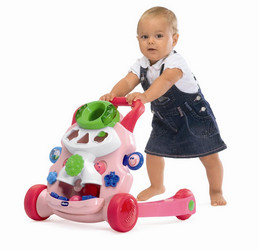
There is a huge number of techniques to properly teach a child to walk: they are all very effective and approved by specialists. You can choose any. The main thing is to follow the general recommendations, which will allow not to lose sight of any nuance. This will accelerate the achievement of desired results.
At what age?
Age, when the first steps are taken, is an individual indicator that cannot be customized to the standards. Some can be pushed to this as early as 10 months, and someone matures for such studies only by 1.2 years. The best option is to teach a child to walk a year, usually by this time he is already formed for this.
Observe him and determine for yourself, it's time for him to stand on his feet or still early. Signs of readiness:
- rises, holding on to something;
- moves along the support;
- actively moving from room to room on all fours;
- finds pleasure in it;
- overcomes small obstacles;
- walks by the hand;
- climbs on low chairs.
Want to teach one year old child to walk? First, determine from these attributes whether he is ready for it. If he expresses reluctance, slowly develops motor skills, but is absolutely healthy, do not force the events. Up to 1.5 years you have time.
Preliminary preparation
In order for the child to take the first steps together with his peers, this must be taken care of in advance. Teach him to walk ... from the cradle. Yes, the preparation of the musculoskeletal system for such a serious event should be regularly conducted from 1 month of life.
- 1 month
10 minutes daily, the newborn should lie on the tummy so that the muscles of the back and neck can get stronger.
- 2 months
Teach your baby to roll over from tummy to back and back. This is easy to do: hold a bright toy in front of it and gradually move it to the side so that it reaches for it. Performing this simple action, he forces almost all muscle groups to work. He will then be easier to climb.
- 4 months
Relying on anything. To do this, you need to carefully pull it by the handles.
- 6 months
He must learn to sit on his own, without support.
- 6-12 months
Make the baby crawl actively. Favorite toys and gymnastics - to help you. Holding his armpits, let him jump on your knees.
In order to quickly teach a child to walk, parents should make sure that their musculoskeletal system develops in accordance with age norms. It was then that by the year he would take his first steps without special training. If this still has not happened, get ready for the "lessons." And they need to start with safety.
According to research. Scientists have confirmed that children who were actively crawling in infancy are easily learnable and successful at school, unlike those who missed this stage and immediately went.
Safety engineering
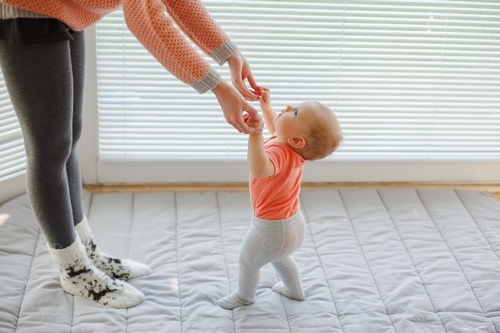
Planning to teach a child to walk independently, without support and support? Then think about safety so that it does not hurt. After all, a negative experience can kill in him the desire to learn the world in this manner. What you need to do to protect it from falls and injuries?
- Learn to walk a child in shoes designed for walking. Soft sandals and knitted booties are not suitable for such activities. Ideal - lightweight shoes made of genuine leather with hard soles.
- Are you afraid that the sole of such shoes will slide on the floor? Walk on it with sandpaper, but do not make too large roughness, which can provoke a fall.
- The surface of the floor should be smooth, flat, so that the child does not stumble. And at the same time, he cannot slide on it, otherwise he will not be sure of his movements.
- Teach him to walk where there are no steps, rapids, rugs, which he can stumble and fall over.
- Remove the spiky objects from the room where the daily activities will take place. Or put on them "stubs".
- If you put a baby in a walker, make sure they are stable. Acquire initially high-quality product that will help avoid falls. Very often, a child who does not yet feel speed, accelerates into them so that he cannot stop, and turns over. It is very easy to break and get a serious injury with such a massive structure.
- The street is not the best place for the first steps.
You will consider a safety issue for practicing with a child down to the smallest detail - teach him to walk much faster. Yes, and they themselves will be calm, that he, standing on his legs, will stand confidently on them, since nothing will frighten him.
After classrooms are prepared, engage in the acquisition of equipment that will help you achieve results in the shortest possible time.
Curious fact. There are several dozen bones in the body of an infant than in an adult.
Inventory
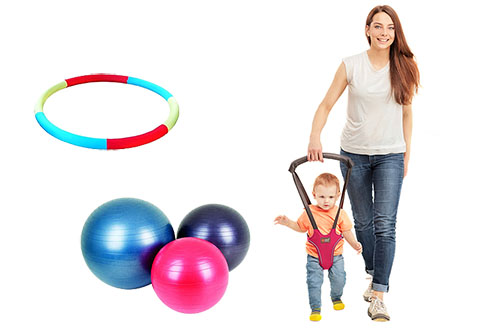
To teach a child to walk, for classes you will need the following equipment:
- leashes (reins) are safety belts and allow you to prevent falls and injuries at first;
- despite the disagreements, in the walker some kids start to walk much faster, as they master the technique and then repeat it without this construction, so it’s worth a try;
- protective helmet on the head for babies will give peace of mind to the most worried moms;
- hoop;
- stick stilts;
- fitball perfectly strengthens the musculoskeletal system.
To teach a one year old child to walk, one inventory will not be enough. Help a small, still forming body to cope with such a serious task - prepare your muscles and joints, daily doing with it strengthening exercises.
Through the pages of history. The first walker was created in 1950 by the Englishman W.C. Robb for the elderly and disabled. And only recently they have been transformed under the use of self-walking babies.
Gymnastics
The purpose of this gym is to strengthen the muscles of the back, neck and legs. She will help you teach your child to walk on a full foot, and not on tiptoe, as often happens. So take a few minutes a day to these exercises - and the first full steps without any support will be made soon.
- Fitball
Seat the child on the fitball with your back to yourself. Hold him by the hips. Swing in different directions. Exercise develops coordination, will teach him to keep balance. All this is necessary for walking skills. Classes can be started from 6 months of age.
- Rack
Teach your child to stand. Squat him face forward on a hard surface. Hold in the chest area. Lift him up, forcing him to rise and straighten the legs. It is advisable to perform the exercise from 9 months of age under the rhythmic music.
- Sticks
If the baby is confident to teach him to walk, purchase special sticks. They are about a meter high, usually polished or upholstered in fabric. Make him take hold of them, put your hands on top of it. Move along these peculiar stilts in turn and take steps.
- Stroller
If the child walks by the hand, but is afraid to let her go, let him roll the stroller himself, while securing it from behind to avoid falling.
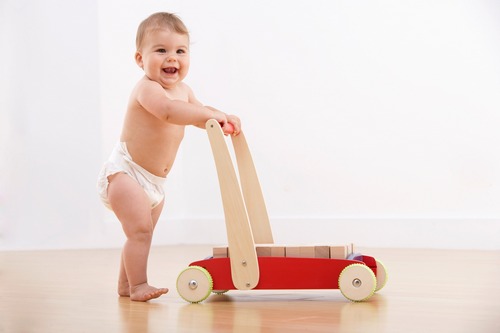
- Hoop
With the help of a hoop, you can teach a child to walk, who can stand without support, but he is afraid to take steps. It runs inside the hoop, which moves the adults in such a way as to make the child move with it.
- Toy hunt
If a child actively crawls and rises with support, this exercise will quickly teach him to walk. Move a bright toy around the room, defining it on a chair, sofa, bedside table - any elevation that will cause it to rise from its knees and take the toy. But if such a chase annoys the crumb, do not need to test his patience.
- Obstacles
If the little man walks by the hand, make him travel around the room with obstacles. Between the furniture pull the rope so that he could see it and step over. Bring him to her, stop, help overcome. When one height is mastered, gradually raise the rope. The destination is the level of the knees. Exercise perfectly develops the muscles of the legs.
They took care of safety, purchased equipment, do gymnastics - everything is prepared for daily activities that teach the child to walk without the help of adults and support.
It is interesting. For the first year of his life, the baby goes the whole way of evolution. According to research, his ability to study at this age is much higher than that of schoolchildren. So do not be lazy - make your crumbs work, knowing the world around us already on legs!
Training
Take for classes certain time of the day Half an hour will be enough. But this must be done regularly, because at this age, acquired skills are quickly forgotten.
- First, teach the baby to walk along the support. Put it near the crib (or sofa), stand on the other end yourself and call him to you, gently talking and beckoning with a toy.
- After that, teach him to break away from the support, holding his hand and pulling up to him. From this position, drive around the room. First, to instill confidence in him, hold it by both hands, but gradually let go of one.
- You yourself will feel when you can release the second hand. But at the same time you must be on guard and catch the child if he starts to fall.
- You can conduct classes together. One adult supports the crumb for the armpits and leads the room. The second one is slightly in front of him and stretches his arms, intercepting the baton and catching the baby. At some point, the first “teacher” already releases the little walker, and the second - makes a corridor from his hands for safety, but still does not hold him. The time interval when the child will be in such free flight will increase every day.
Independent walking on two legs without support and support is a huge leap in human evolution and child development. Parents should help him master this skill, despite the fact that it is laid by nature itself.
Try to instill in him the confidence that everything will turn out, at the right moment - to support, sometimes - to encourage. Make the first steps be a little man in joy and pleasure.
The ability to eat with a spoon is one of the very first independent skills of a kid. For him, this process is no less important than for parents, so the help of adults in such a difficult task is simply necessary.
At what age to teach a son or daughter to eat independently, first of all depends on mom and dad. Scientific studies have shown that children whose parents are not afraid to teach them, allowing them to be more independent, learn to go to the potty or use a spoon much faster.
Do not be afraid to give your baby a little more freedom, so he will feel parental support and care, just as he will not be afraid of disapproval of adult family members. Such a principle is good not only in mastering new skills, but also in other life aspects of a child.
Before you begin to teach a baby spoon-feeding, you need to tune in to the fact that breakfast, lunch and dinner will take two or three times more time, because patience and sincere support are important in this matter. Also, after each meal, you will have to wash everything around you: the table, the chair, the floors and the walls, since the child does not always calmly react to the idea of eating food himself.
How to prepare the baby and when to start eating with a spoon
There are several important aspects that will greatly facilitate the learning process itself:
- Training;
- Learning without a great deal of patience is impossible;
- The individuality of each baby;
- Ability to catch the moment;
- Help your child with failures;
- Constant training;
- The ability to generate interest.
So, consider the most important points in order.
How to prepare
If a child eats from the very birth under cries and tantrums, or until the parents switch on cartoons, it will be more difficult to make him want to eat on his own. This problem has a way out. Even the youngest children like it, if the whole family gathers around the table, it gives interest to any meal. The child will see that adults eat differently from him and most likely will try to repeat it after them, taking the spoon away from the mother or father.
So that everything works out from the first attempts, allow him not only to take away the spoon, but also to take food with his hands, but in no case force him to eat food. It is proved that if you forcefully teach a child to eat, then this method will soon discourage all desire to take a spoon in hand.
Now let's talk about patience. Many parents love to teach children to eat themselves, using the phrase: "eat faster", "stop distractions" and so on. Try to exclude similar phrases during direct communication. When a child eats, he not only satisfies the feeling of hunger, but also gets pleasure, for him it is a kind of game that cannot be rushed, otherwise the whole desire to play will disappear. Better to praise him and cheer him up every time he put a spoonful of food in his mouth.
Consider individuality
It is important to always remember that each person is individual, so you need to look for your own approach to any of them. In books devoted to the topic of self-catering, they write that children by one and a half years simply have to eat themselves. You should not drive the child into this framework and strive to achieve the ideal, because some children do not want to eat themselves for three years and require that they be fed, but it is impossible to meet a ten year old who has not yet learned to eat himself.
Constant training is very important, as the child must memorize the skills he needs. Hardening skill can be in the sandbox. Put an empty bucket next to the baby, give him a spatula and ask him to fill the container with sand.

Support
Quite often, a child whose something does not come out, begins to be capricious, cry and scream. At this moment he will need the support of his closest people - his parents. This is one of the most important reasons for being with a baby during dinner. In addition, the baby can pour porridge on himself or choke; in these cases, the presence of adults is simply necessary.
Interest in eating
Everyone knows not by hearsay that tasty and healthy food often looks on the plate completely unattractive, but adults, unlike children, understand that taste is completely independent of appearance. How to make the child have a desire to eat?
— In a good way will decorate the dish. You can cut out flowers from flowers, funny faces or stars.
- Buy a plate with a beautiful pattern on the bottom, impose a meal and tell the child that when he eats everything himself, then a surprise awaits him. This will arouse interest in the very process of eating and will allow this option to be used repeatedly.
At what age does the baby begin to eat food itself
As mentioned earlier, each child is an individual, so you need to choose certain ways to teach your baby to master the skill and use the spoon as intended, but, as a rule, the ability in itself comes already by one and a half years.
In most cases, by the age of 7-8 months, the baby is already confidently sitting in the highchair and quietly allows the mother to feed him. In addition, he can quietly take pieces of bread from a plate and send them into his mouth. It was at this time that psychologists advise starting to arouse children's interest in the process of self-feeding.
At 9-10 months, the child himself eats from a bottle, tries to drink from a cup and grabs with his hands not only pieces of bread, but also food from a plate. It is important that the food is not very hot, otherwise the child may get burned. At this time, be patient, because you have to not only patiently teach the child, but also wash the kitchen several times a day.
At 11-12 months, the child should literally snatch the spoon from the hands of the mother and try to repeat the process behind it. Sometimes it works, sometimes not. At the moment everything will depend on the parents and their support. Adults may consider this behavior capricious, but it is not. Snatching is the need to learn how to use cutlery as parents do, so try to encourage it in any way.

At 15 months, the child should already be free to distinguish between dishes and point the finger at the fact that he seemed to like it more than everyone else. The kid already knows how to confidently use the spoon, but not often brings food to the goal, most of the soups and porridges will be on the table, clothes, floor and walls.
At 21 months, the baby makes the very first and significant successes in mastering a spoon. The food is not so often on the clothes, and the child eats with much greater pleasure than before. In addition, he will learn to hold a glass for quite a long time, without spilling its contents onto himself.
The basic rules in this article, we have already disassembled, but there are two more, no less important:
- In no case can you do for a child what he can do himself. This applies not only to breakfast, lunch and dinner, but also to other aspects.
- You cannot teach a child against his will and make demands on him that he is unable to fulfill, because in most cases this behavior causes a categorical unwillingness to learn to eat food on his own.
All children, even peers, develop in different ways: one baby will start walking by 9-10 months of life, and the other - by year. Some children, even in a little over a year, are afraid to let go of her mother's hand and go without support. How to teach a child to walk?
Today I’ll tell you how to prepare a crumb for the first steps, develop independence and interest in walking without outside intervention.
Preparatory stage
A lot in the development of a newborn depends on what is laid in the first months of his life. Therefore, long before teaching a child to walk independently, prepare the child’s body for further exertion.
A kid who moves a lot, shows persistence in his movements and behaves actively during the day, will begin to walk faster than his lazy and phlegmatic peers.
There are very simple procedures, the daily implementation of which will accelerate physical development:
- Laying on the belly. From the first weeks of life you should not do this, but when the child learns to roll over on his stomach, encourage him to spend as much time as possible. So he will strengthen the muscles of the neck and back;
- “Freaks” is an exercise that is easy to perform during regime moments, for example, during a change of T-shirts or diapers. From the age of two months, the child attempts to rotate and. As a result, the muscles of the back, neck, legs and arms develop. Encourage coups, try to turn these exercises into a fun game.
- Active movements: starting from 4 months, the baby tries to sit down with the help of parents, by 8-9 months he is already. So that he will not be long in one place, ask him to reach the toy, crawl up to it - so he will have an incentive to walk.
- Walking together is great! Half year old children love to crawl, any object that attracts attention, makes the baby try to get it. Parents who encourage motor skills help the child develop new spaces. And this, in turn, stimulates the baby to train faster movement options, such as walking.
- Strong muscles - walking properly. In order for the legs to confidently hold their master, the baby must thoroughly learn how to bend and unbend his knees, bounce with the help of his parents.
Top-top, stomping baby ...
The child is already beginning to show independence, moving with the help of support? Can he, holding the furniture, walk from one end to the other?

During this period, many parents come up with ways to teach a child to walk so that he can run on his own in a little over a year.
First of all, the baby should feel the support of adults. For example, you can take his hand and go together: see how the cat washes, as seen from the window, who returned home after work.
The boys will be happy to walk and push the tolocar in the form of a car in front of them, and the girls will have a doll stroller for which it is convenient to grasp, walk and roll forward. When a child is 11-12 months old, the question of how to teach to walk may not be as relevant anymore.
If there are still walkers in the house, you need to remove them so that the baby will forget what it is. The phase of active walking should take place in a natural way, and not limited to the seat and bumper of the walker.
Walkers are a very controversial device. In my opinion, from this device more harm than good: in them, the baby can not properly sit and walk, he constantly shifts the center of gravity, relying on the walker.
Remember that the more you encourage the desire to walk in a child, the faster he will learn it. You can sit on his knees a few steps away and ask him to walk to his mother's arms. Children love such “hikes” very much, the consolidation of walking skills and cheerful laughter will surely be guaranteed.
Choosing shoes
Little runners need the right "boots". The choice of shoes must be taken very seriously, because how quickly the child feels in the shoes depends on how quickly he begins and how he will walk. Baby should wear shoes with pleasure, and therefore, you should pay attention to the following points:
- size (no need to buy shoes for growth);
- heel height (should not be low);
- a sole (elastic, with an instep support);
- a fastener (the best is “stickies” - they are more convenient to use).
The shoes themselves should be chosen together with the child so that he can walk in it, and you can see if the model is comfortable, how well it is sitting on the leg, and whether there are red spots on the leg. For children with orthopedic problems, doctors prescribe special medical or prophylactic shoes; attention should also be paid to this point.
It is useful for a baby to walk at home barefoot, it is stop-therapy and hardening “in one bottle”. Now extremely popular are the rugs with different bulges that massage and at the same time strengthen the legs: teach your child to walk on them.
If you are afraid that barefoot crumbs can catch a cold, then you can put on socks with a special sole, it has a rubberized pattern and prevents slipping on the floor covering.
Important! If a child is registered with an orthopedist due to improper placement of feet, walking in special shoes, even at home, can be prescribed. In this case, you need to consult with a specialist.
Psychological attitude of parents
Psychological overtones of the illuminated problem are very important, because often parents start to sound the alarm, look for a five thousandth way how to teach a child to walk, what Komarovsky says on this topic and in general why their child is not as smart as everyone. There are a few tips on how to overcome the “fussy parent” syndrome:
- My baby is an individual. Understand that your Peter and the neighbor Mitya are different people. Read more in the article, “?” If Mitya rushed like mad from 10 months, and Peter uncertainly and holding his mother’s hand went into the year - this is not a reason for panic. Just the time has not come yet. Find out what to do if \u003e\u003e\u003e.
- If the baby often stumbles, falls and does not want to let go of the father’s hand for a walk, except for the orthopedist and the neurologist, you can consult with an optometrist. Sometimes a crumb cannot walk on its own due to vision problems;
- Constantly causing the child’s interest in walking, showing one’s own example is one of effective wayshow to teach a child to walk without support. It is easy to carry away children with something interesting, so just turn on imagination and ingenuity ..
How to teach your baby to walk and what shoes you need to choose, see the video:
Fix bugs
It so happens that parents, who have not figured out how to quickly teach a child to walk, come up with their own methods and make mistakes. Naturally, some blunders do not help, but make it difficult for a child to master the art of walking. Below is the ranking of the most common parental error actions that should not be repeated:
- Use walkers and jumpers. A lot has been said about the first ones above. In short, discard their use while the crumb learns to walk, or replace it with machines that can be pushed or play centers with a cognitive resource;
- Parents should not put their babies on their feet too early, in an attempt to teach walking. The kid will do it on his own when his muscles and bones get stronger. If you artificially speed up this process, you can contribute to the development of flat-footedness and disorders in the development of the spine;
- In addition, the toddler should not “stand up” for too long near the support - he needs to learn to squat, otherwise the foot may be deformed due to the stretching of the ligaments;
- Poor quality shoes - a serious blunder for parents. Children’s shoes, especially small ones, cannot be saved in any way. Only high-quality orthopedic shoes help the musculoskeletal system to develop properly and encourages the baby to walk, making this process enjoyable;
- Hyper-drug cannot in any way promote independence, and mother’s nervous shouts: “Carefully, you will fall!” Are unlikely to give a tiny bit of confidence. The wider the horizons for travel, the better, and my mother's hand should simply be support and safety net.
As a rule, reasonable parents who avoid such mistakes know how to teach a child to walk, this is clearly demonstrated on numerous videos on the net. They are depicted kids who gladly stomp for mom, push the doll carriage in front of them and dance to their favorite music.
The older the baby gets, the more independent it wants to be. Now he himself takes the bottle and drinks from it, he puts the toys in the basket, but how to teach the child to eat with a spoon? Often for parents this question turns out to be no less important than even the question of potty training, because an independent meal is an important stage in the development of a baby. We will try to deal with the problems and difficulties that often accompany the schooling of crumbs for independent meal.
When should you start teaching your child to eat with a spoon?
All children develop in different ways. Someone takes a spoon and tries to pick her in his plate as early as 10-12 months, someone puts off this training for as long as three years. Of course, the sooner you teach your baby to use cutlery, the better. And even more so do not need to pull with it, feeding the child.
Experts say that to begin to teach a baby to a spoon should be at the age of 10 months, and by the age of one and a half, the child himself must confidently wield this cutlery.
The main mistake that some parents make is excessive care. Moms do not give the baby a spoon, even when he tries to take it and interfere with the food in the plate. There may be several reasons for this. Someone thinks that, feeding the crumbs on their own, they show care and attention. Someone just does not want to once again clean the kitchen. Both approaches are incorrect. Babe must be taught to spoon. If only because this is one of the requirements when preparing a child for kindergarten.

Which spoon to choose?
It is very important to choose the right spoon so that the baby is comfortable using it. For children, you can use the following spoons.
- Silver is a tribute to tradition. Often silver devices give the baby godparents on the day of Epiphany. The advantage of silver is that it disinfects food.
- Rubber - is good because it does not injure the gentle mouth of the baby, but it is only suitable for the introduction of complementary foods. The crumb cannot use such a device on its own, as it is too inconvenient for uncertain children’s fingers.
- Anatomical is a special development designed for the smallest. It is convenient to hold such a spoon in your hand, it is just to scoop food. But the device has a significant drawback: after getting used to the anatomical spoon, it will be difficult for the baby to eat the usual one.
- A teaspoon is a classic. Mothers and grandmothers fed us with such spoons. It is convenient, compact and ideal for learning.
For children from 10 to 18 months, you can use plastic spoons. They are light, colorful, perfectly fit in the children's pen. Due to the variety of forms you can choose the most convenient device.
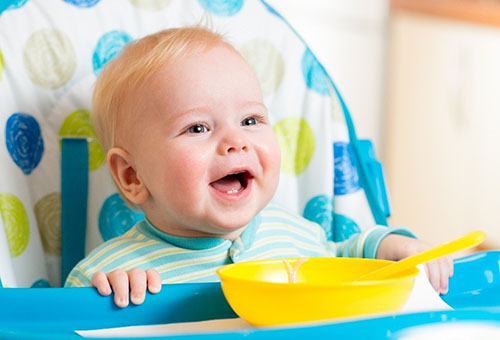
How to teach your baby to eat by yourself?
So, your baby is 10-12 months old, and you decided to teach him to eat on his own. You have already chosen a suitable spoon and, maybe, even bought a plate on a suction cup, so that it would be more convenient for the child to scoop out food from it. But what next?
There are several basic rules for teaching the crumbs of independent ownership of cutlery.
- Watch baby. As soon as you notice in him even the smallest interest in a spoon, immediately give it to him in the pens. Even if it happens at seven months and will not bring any results, except for the table covered with food.
- Interest your baby. From the very beginning, let the child know that eating is a responsible and important matter. No need to plant a child in the living room and feed him while he watches cartoons. Teach the baby "from the cradle" - you only need to eat in the kitchen, in peace and quiet. Well, if the child will have dinner with the whole family at the table. This will develop the right attitude towards food intake and will prompt him to quickly learn how to wield a spoon with his own spoon.
- Create a pleasant atmosphere.Do not rush the child, be friendly and tender. Let the meal last as long as your baby wants.
- Do not refuse help. If the baby doesn’t do everything and he’s upset about it, help him. Send your pen to your mouth with your hand, or show by your example how to hold the spoon.
- Teach playing.Practice shows that kids who often play in the sandbox, it is easier to get used to the spoon. It's all about such a child's toy, like a spatula. It resembles an enlarged copy of an ordinary spoon and perfectly trains skills in the use of cutlery.
- Let me choose.Some kids are easier to get used to the fork, rather than a spoon. Provide a choice: baby spoon or plastic fork with blunt ends.
- Start with delicious.Prepare your favorite dish for your baby, but it should not be too liquid by its consistency. Soup or mashed potatoes do not fit, but porridge - the most it. Decorate the dish with berries and fruits, so that the crumbs are pleasant to eat.
Many parents do not know where to start schooling with a spoon. In general, we can distinguish the following sequence of actions.
- Cover the table and the floor around the high chair with oilcloth.
- Attach a velcro plate to the countertop and place food into it.
- Put the bonnet on the baby (so that he doesn’t get his hair dirty) and tie a bib.
- Stand in front of the baby and spoon a little porridge from his plate. Swiftly swallow food and praise yourself - this will give the kid an example.
- Next, hand the device to the baby. If he cannot hold him, hold the spoon in his palm with your hand and scoop the food from the plate.
- Help the baby eat until he can hold the spoon himself.
Be prepared for the fact that the whole child and objects around him will be soiled with cereal. Do not worry, the children learn quickly, and very soon your crumb will more accurately convey the spoon to the mouth.
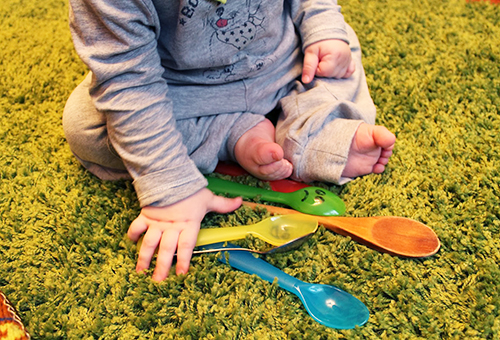
- Inform all households in advance that they are teaching the baby to handle the spoon on its own. Do not allow someone to feed the child himself.
- It is not necessary to force the baby to eat independently, if he has a pain.
- It is better if meals will occur at the same time.
- Some parents feed the children in the bathroom to make it easier to wash the baby and yourself - this should not be done.
- It is better to teach your child to eat independently in the summer. At this time of year, you can strip him down to his panties, and when he gets dirty, immediately wash.
- Do not be annoyed and do not despair if your baby does not get everything.
- If the child is tired of eating with a spoon, feed him.
- Do not force the crumbs to eat cutlery. Wants to eat with hands - please! In any case, over time, the baby will want to be like adults and take a spoon.
The last piece of advice, perhaps, can be called key, and not only in the matter of accustoming to cutlery. Many methods of education (the Montessori system, Doman's method, etc.) are based precisely on giving the child freedom, so keep in mind that imposing a spoon on the child will only increase the period of getting used to it.
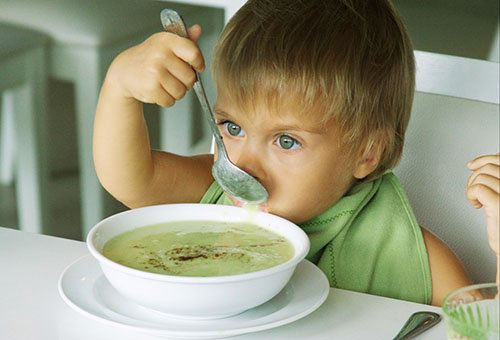
Stages of addiction to the spoon
There are several stages that each child goes through in the way of his self-catering training.
- Stage "Game". The child clumsily takes a spoon, twists and plays it. For him, this is only a beautiful toy.
- Stage "Copy". The crumb tries to repeat the movements of adults, but because of poorly developed coordination to bring the spoon to the mouth of the baby does not work.
- Stage "Training". The kid already quite consciously takes a spoon and even eats with it. However, sometimes the food falls, not reaching the mouth.
- Stage "addiction". The child almost never drops food from a spoon and eats quite well himself.
- The final stage. Baby confidently and calmly eats himself.
Conclusion
Be patient and restrained, and then your crumb will very quickly master the skill of owning a spoon. There is like an adult every child wants, so do not doubt that in the end the child will learn to eat on his own and will receive a lot of pleasure from it.